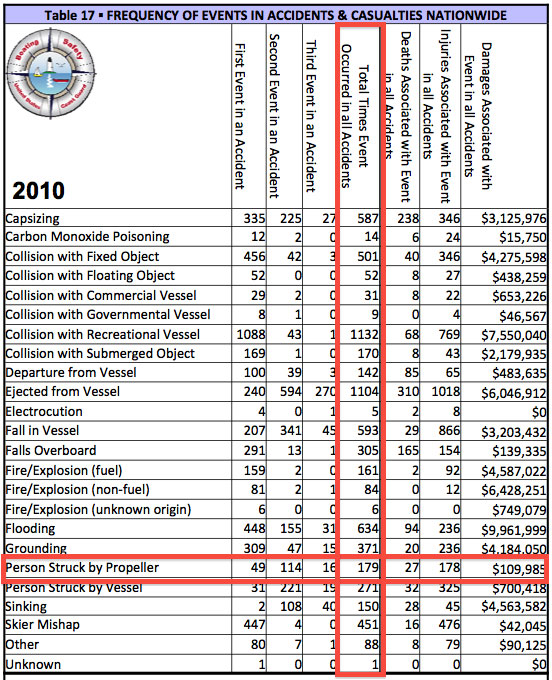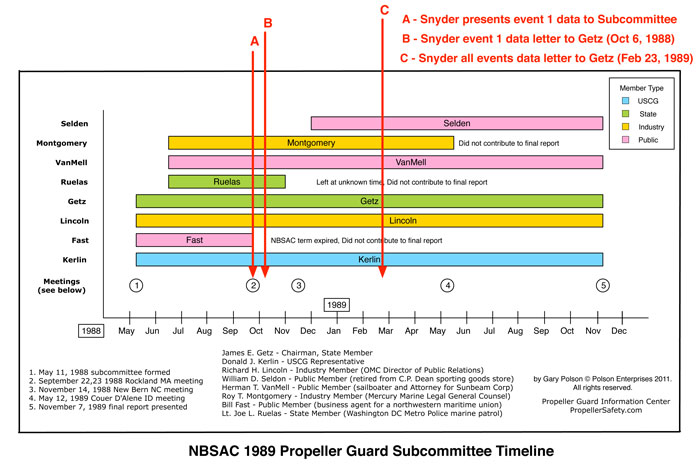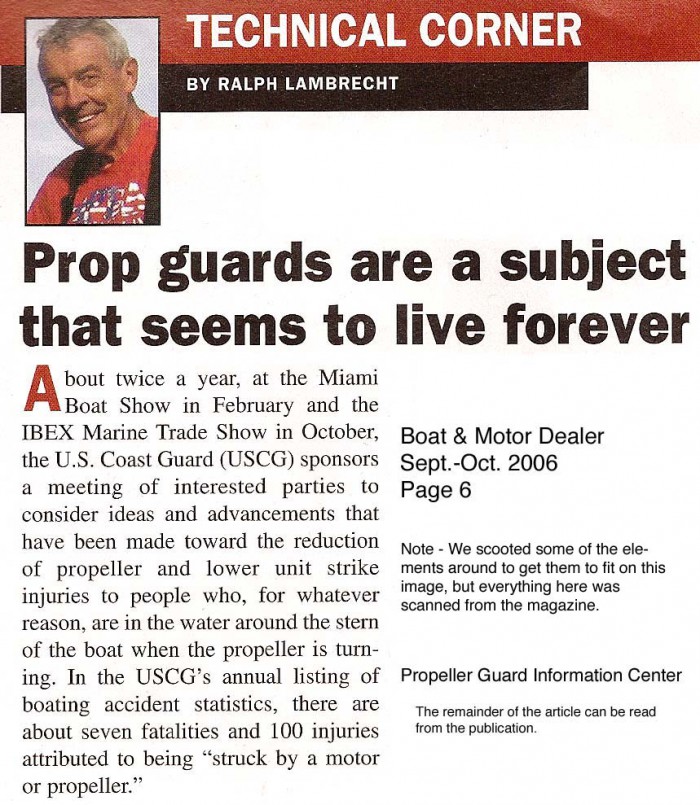Boating Industry Provides Misleading Propeller Accident Statistics
The boating industry has a long history of misleading the public and authorities by providing recreational boat propeller accident counts much lower than the official accident statistics provided by the U.S. Coast Guard.
Several of these instances result from the industry falsely using Event 1 only statistics to represent the total number of propeller accidents, injuries, or fatalities. U.S. Coast Guard reports accidents as a sequence of events (like Event 1 = collision with submerged object, Event 2 = fell overboard, Event 3 = struck by propeller). Most propeller accidents tend to be reported as Event 2 or Event 3 accidents. Something else happens first, like a collision with fixed object, collision with submerged object, collision with floating object, collision with recreational vessel, falls overboard, etc, then the person is struck by the propeller.
We highlighted a table from USCG’s 2010 Boating Statistics below as an example.
USCG’s 2010 Table 17 above shows 179 accidents, 27 deaths, and 178 injuries from Person Struck by Propeller. The industry keeps wanting to use the Event 1 data only to the left (49 people struck).
From 2003 through 2012, there have been about 49 to 107 Event 1 propeller accidents per year with about 1 to 8 fatalities per year resulting from those Event 1 accidents.
However, during the same years there have been a total of about 176 to 266 propeller accidents per year with about 19 to 47 fatalities per year resulting from those accidents per USCG.
When the industry only cites Event 1 accidents they are significantly misrepresenting the total number of reported propeller accidents.
We have covered some instances of the boating industry misrepresenting these statistics in the past. We recently encountered another one, and decided to pull some of them together into this post.
- Dick Snyder, Mercury Marine propeller accident expert and industry expert witness – 1988 presentation and letters concerning the upcoming 1989 USCG National Boating Safety Advisory Council (NBSAC) Propeller Guard Subcommittee Report.
- Bill Calore, General Counsel Volvo Penta – Presentation to NBSAC 1996.
- Ralph Lambrecht, longtime OMC technician and industry expert – Boat and Motor Dealer. Sep/Oct 2006.
- Don Kueny, OMC Chief Marine Engineer – the June 2009 Audrey Decker trial.
- Pete Chisholm, Mercury Marine / Brunswick Corporation – the Jacob Brochtrup trial (April 2010) and in Brunswick’s request for a rehearing (June 2011).
Dick Snyder, Mercury Marine
Richard “Dick” Snyder, long time propeller accident expert for Mercury Marine participated in several meetings of the 1988 / 1989 NBSAC Propeller Guard Subcommittee. The Subcommittee’s final report recommended not using propeller guards. That finding is still cited by the boating industry in defending themselves in propeller accident trials. We cover the NBSAC Subcommittee and the processes used to arrive at the final report in depth at NBSC Propeller Guard Subcommittee Report 1989.
Dick Snyder’s 22 September 1988 presentation to the Subcommittee and his subsequent 6 October 1988 follow up letter to Jim Getz (Chairman of the Subcommittee) provided propeller strike statistics. Snyder’s presentation and letter provided Event 1 fatalities (an average of 13 fatalities struck by boat or propeller per year from 1979 to 1987) and presented them as representing the total number of struck by boat or propeller fatalities. The truth was they represented less than half of the struck by boat or propeller fatalities reported by the Coast Guard. Snyder’s low ball statistics prejudiced the subcommittee by underestimating the seriousness of the problem.
Dick Snyder, the industry’s leading expert, wrote Jim Getz on February 23, 1989 of his “discovery” that USCG reports accidents as a series of events. Snyder provided new fatality data (an average of 30.4 fatalities struck by boat or propeller per year) in this letter based on all three events. However, as seen in the timeline below, the Subcommittee had already met for three of its four working meetings, and some members were already gone from the roster. We see can find no record of Getz sharing this new found information (higher fatality counts) with the rest of the Subcommittee AND Snyder’s new found statistics are not in the final report. We reworked one of our earlier NBSAC 1989 timeline graphics to show when Dick Snyder presented, wrote the “Event 1” followup letter to Getz, and then later wrote the “All Events” letter to Getz.
The timeline clearly shows how late the correct Coast Guard data was provided. The 1989 Subcommittee on Propeller Guards found no need for propeller guards which appears to be at least partially based upon Snyder’s earlier misleading statistics.
Bill Calore, Volvo Penta
Bill Calore was General Counsel to Volvo Penta when he submitted Volvo Penta’s public comments to Proposed Rule 95-041 on August 29, 1996. Those comments included a copy of Calore’s April 29, 1996 Presentation to USCG’s National Boating Safety and Advisory Council (NBSAC) in San Francisco California.
Calore’s presentation includes this quote:
“Of over 31,000 boating accidents reported to the Coast Guard for the years 1989-1993, only 17 have involved ‘Struck by Boat or Propeller’ type accidents.”
USCG supplied a 1988-1993 BARD print out of individual struck by boat or propeller accidents with a proposed propeller safety rule. In it, USCG provides details on 890 struck by boat or propeller accidents. Volvo Penta said there were only 17.
We suspect Bill Calore came up with “17” from houseboat propeller accident data USCG provided with the proposed displacement boat propeller safety rule.
Ralph Lambrecht, Longtime OMC technician and Industry Propeller Guard Expert Witness
Ralph Lambrecht’s column in Boat and Motor Dealer Sep/Oct 2006 titled “Prop Guards Are a Subject That Seems to Live Forever” said there were about 7 fatalities and 100 injuries per year attributed to being struck by motor or propeller.
Lambrecht is incorrectly relying on Event 1 only data to represent the total number of propeller accidents, injuries, and fatalities. Its 2006 and Lambrecht still hasn’t “discovered” what Snyder discovered back in February 1989. He is still testifying in court for the industry.
USCG Boating Accident Report Database (BARD) data actually indicates about 30 to 45 people were killed annually and approximately 185 to 265 were injured per year from 2001 to 2004.
We confronted Lambrecht with the actual data and he refused to correct his article. Our lengthy exchange with him is online in How One Boating Trade Magazine Responded to the Truth. In April 2007 Lambrecht finally published this statement speaking of propeller accidents, “It seems clear that such things do occur more than half a dozen times a year …” but he provided no numbers.
Interestingly, Lambrecht’s publication (100 accidents, 7 fatalities) is probably the source used by Mikal Watts and Don Kueny in the next segment.
Don Kueny, OMC
Don Kueny starting working for OMC in 1957 after he received his bachelors degree in Mechanical Engineering. Kueny rose through the ranks to Service and Manufacturing Engineer at Corporate Marine Engineering in 1965, to Chief Engineer for Marine Engineering in 1975 where he remained til his retirement in 1993.
In the Decker trial (June 2009) Kueny said he was one of about twenty people at OMC that received the annual Coast Guard accident statistics from the mid 1970s forward. (transcript pgs. 658-659).
Mikal Watts, lead attorney for Decker, made the common mistake of interpreting Event 1 USCG accident statistical data as representing the total number of accidents. Watts asked Kueny, “the Coast Guard reported officially 100 propeller-strikes injuries in the United States per year?” (transcript pg 661). Kuney said he did not recall that data, but since Watts had it printed he could not argue with it. We suspect Watts may be showing Kueny the Lambrecht article discussed above.
Once again, Watts asked, “In terms of a working number, that is a number you’re familiar with, that in terms of the repetity of the hazard, at least the Coast Guard was saying a hundred prop strikes on average?” (transcript pg. 662). Kueny said, “If you say so, I don’t remember it being that high, but I can’t disagree. You’ve got the data. (transcript pg. 662).
Keuny even wanted to reduce Event 1 counts. Audrey Decker was struck in 1999, and the trial was in 2009. From 1999 to 2007 (probably the last report available at trial time) Event 1 struck by motor or propeller data was (99,88,100,90,107,64,100,107,80) which is probably where Watts came up with “100” as an approximate annual frequency if he did not use Lambrecht’s article above.
Naples Daily News (NDN) did a great job of blogging the trial. Their June 6, 2009 coverage presented some of the specific data shown by Watts. NDN incorrectly used Event 1 statistics when they wrote Federal statistics showed more than 80 propeller accidents in 2007, the most recent statistics available. They went on to note that was down from 2006 when there were 107 accidents resulting in 98 injuries and 8 deaths.
We quickly emailed the Naples Daily News reporter covering the trial, explained the way USCG records accidents as a series of events, how to correctly read the statistics for total events, pointed them to our Statistics Page, pointed them to our Propeller Accident Statistics Guide for Reporters, and posted similar content on our page covering the Decker trial.
On 9 June 2009 Naples Daily News more correctly reported there were 176 boat propeller accidents in 2007 with 24 deaths and 166 injuries.
When Watts gave closing arguments for Decker on June 22, 2009 (transcript pg. 2862) he closed with 2002 data:
“I told you OMC was aware of seven (fatalities) and 100 reported prop strikes per year. That number turned out low. Mr. Kueny agreed he was aware of Coast Guard statistics claiming hundred prop strikes a year.
You have all seen more recent statistics 236 (accidents) and 47 deaths. Those statistics are not unusual.”
In summary, when the attorney mistakenly confronted Kueny with Event 1 only data, Kueny did not even want to accept those low numbers. Kueny said he did not remembers the numbers being that high. After we called the attention of the press to the correct data, the attorneys learned how to properly interpret USCG annual accident statistics and used them later in the trial.
Peter Chisholm, Mercury Marine
We previously covered Pete Chisholm’s statements in the Jacob Brochtrup trial in Brunswick Misled Two Federal Courts on Frequency of Propeller Accidents.
At the time of the Brochtrup trial, Pete Chisholm was being groomed to take over Dick Snyder’s spot as Mercury’s long time propeller accident expert.
The following comments were made in the Jacob Brochtrup v. Mercury Marine & Sea Ray trial, and used again in Brunswick’s request for a rehearing (dated June 10, 2011).
Mr. Alden is Robby Alden, attorney for Brochtrup. Mr. Norwood is Colvin Norwood, an attorney for Brunswick. Pete Chisholm is on the witness stand answering the questions. These are Pete Chisholm’s answers on 1 April 2010.
Q. (BY MR. ALDEN) As an employee of Mercury Marine and somebody that’s responsible for product — I’ll rephrase the question.
As an employee of Mercury Marine, somebody that’s involved with product safety, you pay attention to dangers and hazards which your products use, like the number of people that get injured each year with propellers, don’t you?
A. Yes, sir.
Q. And you know that hundreds of people get injured seriously every year with boat propellers?
MR. NORWOOD: I object as outside the scope of the record. There was no questions at all about this.
THE COURT: Well, he’s the safety project — he can answer that.
A. I’m a aware that there are a number of injuries every year that occur, but I don’t believe that number is a hundred a year.
At that time, annual propeller strikes recorded in BARD were running in excess of 175 per year.
Mercury included Chisholm’s testimony above as a reason for a rehearing in their June 10, 2011 request.
Pete Chisholm had been groomed the last few years to take over as the next industry propeller accident expert as Dick Snyder heads toward retirement. Is Chisholm really not familiar with USCG propeller strike statistics? He is the person who had been speaking for Mercury Marine’s efforts in this field at NBSAC. Pete Chisholm was Chairman of NBSAC’s Boats and Associated Equipment Subcommittee (safety issued with boats and equipment on boats) in 2010 and 2011. If Chisholm did not understand USCG’s propeller accident statistics, even after they were presented many times at NBSAC, did he understand USCG statistics for other types of boating accidents?
PGIC Comments
The boating industry has repeatedly misrepresented U.S. Coast Guard propeller accident data to the courts, to the public, and to consumers.
People that should be regularly following propeller accident statistics (propeller accident expert witnesses for the major firms, General Counsel for a marine drive company, Chief Engineer of Marine Engineering at a marine drive company) at major industry firms (Mercury Marine / Brunswick, Volvo Penta, Outboard Marine Corporation / OMC) either did not correctly understand how to correctly interpret annual statistics provided by the U.S. Coast Guard, or they deliberately misled others (including the courts).
These are the people that should have been driving for solutions at their respective companies. If they did not understand the statistics correctly, they would have underestimated the degree of seriousness of the problem. As a result, their companies may not have applied the correct level of resources to the problem.
AND EVEN WORSE, if they did not understand how to properly interpret the statistics for propeller accidents (which are sometimes said to represent only about 5 percent of all boating accidents), they did not understand how to interpret the statistics for other kinds of boating accidents. This is a case of an industry either being asleep at the wheel, or of an industry intentionally misleading the public, the Coast Guard, and the courts.
In real life, propeller safety advocates and industry experts have long battled over the number of unreported or under reported recreational boat propeller accidents. But to still be battling about how to correctly read and interpret the U.S. Coast Guard Annual Boating Statistics is ridiculous.
We urge the industry to:
- Make sure their product safety and engineering people understand how to correctly read the total number of accidents, injuries, and fatalities from USCG’s annual Boating Statistics for all types of boating accidents listed there OR create their own internal easy to read summary with the correct “All Events” statistics and distribute it, such as via the National Marine Manufacturers Association (NMMA).
- Quit misrepresenting USCG recreational boat propeller accident statistics.


